#spoiler alert it is repo man
Text
TS2 dev comments about wants
At some point I fiddled with WantTrees and noticed there are many comments left behind by devs who worked on TS2, mostly considering how wants work for different aspirations.
Some of them seemed interesting so I started copying comments to a separate file... and then forgot about it. Well, I was cleaning my desktop just now and found the file again.
Since these might be interesting for other TS2 nerds as well, a random collection of TS2 dev commentary about the wants under the cut!
(I edited out the abbreviations and random typos to make these easier to read. Spoiler alert for, uh, exposed game mechanics?)
When a Romance Sim buys a fireplace, they want to use it. When a Family and Knowledge sims lights a fire in a fireplace, they fear fire, Family death.
Sims want to chat and send email after buying a computer. Elders fear email once.
When a Sim sees another Sim die, they want to beat the grim reaper. Must be short-lived.
Family Parents with strong personality traits will want their children to be more like them. Wants are exclusive for personality, needs min rel with child. Recurs after sleep.
After owning a lot of outdoor growing plants, Fortune Sims want a gardener.
Sloppy Sims hate changing a diaper after they have a child/adopt a child/have a grandchild. Lasts until the child is no longer in diapers.
Family Sims who have their children taken by the social worker want a baby.
After reaching creativity level 3, a Sim wants to buy a new creativity skill object.
After having a fire, sims want a fire alarm.
If a Popularity Sim has a lousy party, they want these objects which help make parties better.
Fortune Sims want to hire an exterminator when they see vermin. Family too.
Sims who buy hot tubs and double beds want to woohoo in them.
The Popularity Sim wants to make Friends, then Best Friends with another Sim after meeting them.
Teen Romance Sims who make out twice with the same sim want to meet someone new.
Sims who are sick worry about the downsides.
Knowledge Sims who have been shocked will fear being shocked again if an object breaks.
Fortune sims want the handyman to fix things.
Child's wants regarding building friends. If they lose repeatedly, and they are mean, they want to fight.
The Popularity Sim wants to make espresso for guests if they have an espresso machine; the behavior is triggered each time they entertain, play or talk.
Fortune Sims want to marry Rich if they have never worked, if they have had their stuff taken by the repo man (they are poor), or if they are getting old and are unmarried.
Makes the Romance Sim who has had a WooHoo want it in different objects, and want it again with the same sim the next day, but with less and less intensity each day that goes by.
Repeating cluster where non Popularity Sim wants to socialize with their best friend every 6 hours, strengthening as the relationship becomes stronger. This makes the Sim focus more on Sims who are their best friends.
Once having maxed the creativity skill, Sims want to write a great novel or paint a great painting. Once having sold a great novel/painting, they want to quit their job and keep doing it.
Progressive social tree for Romance Sims after being tickled. Lets the Sim who has been tickled with "binge" for a while on relatively easy, short term, high ad wants.
After eating a food prepared to some minimal level of quality, the sim will want to eat that food at the right time of day, for about as long as they are the current age, then it dies away. Sims who are "off schedule" may not have this behavior due to food type unavailability.
Wants for Sims who were Best friends/Steadies/relatives of the Sim who went to college. Drives wanting to maintain the relationship, wanting to follow Sim to college where appropriate, and wants for the college Sim to do well/fear doing badly.
Romance Sim wants to socialize with their Lover every 6 hours, weakening as the relationship becomes stronger. This makes the Sim focus more on Sims who are approaching the point of losing the Love Bit bit, making the Sim try to retain love relationships. When the relationship rises, however, the Sim will focus more on relationships which are not yet developed into Love.
#text#text post#ts2#the sims 2#sims 2#random#the file was dated may 2021#yeah this is how often i clean my desktop
521 notes
·
View notes
Text
i know what i wanna do for halloween next year but will the hyperfixation return
#spoiler alert it is repo man#blah blah blah#am i gonna watch repo again now that it is 10 pm on halloween night?? to pretend i am fulfilled in my desire to cosplay him??#yes#well maybe#one more day of work tomorrow#so i shld probably sleep#but god theres a blind mag cosplayer on tiktok and shes gorgeous and i wanna.......... be part of that tiny fandom on tiktok#like the ppl who are cosplayed are mag and shilo and pavi. and theres like one luigi. i might have seen an amber??#oh yea and several graverobbers#but i wanna............................. i wanna be nathan/repo man#it would be fun to do a gentern also but#leather jacket..... sexie#leather jacket COMPLICATED LOL#the pleather i have has been designated for my org xiii jacket and i cannot and will not allow that to be used for anything else#i was gonna try to make the org xiii jacket for last halloween ALAS....... i pussied out of it bc i was intimidated#yaya han: 'i wanna make cosplay affordable and achievable for everyone!' *makes fabric stupid expensive*#i - a known fool: *purchases her stuff anyway*
1 note
·
View note
Text
I just watched Repo! The Generic Opera for the first time recently and Nathan Wallace/the Repo man give me hardcore Jonathan Crane/Scarecrow vibes. Just me?
#personal#repo! the genetic opera#nathan wallace#batman#jonathan crane#scarecrow#repo man#maybe i just have a skewed interpretation of their characters#its nuanced#spoiler alert i love them both
30 notes
·
View notes
Photo



5 Small Pleasures From MARS ATTACKS! by Pablo Kjolseth
There are many obvious reasons to see Tim Burton's MARS ATTACKS! ('96). The composer is his long-time collaborator and the one-time Oingo Boingo front-man, Danny Elfman. The cinematography is by David Cronenberg's go-to-camera guy Peter Suschitzky, The cast features off-the-charts star-power that includes Jack Nicholson, Glenn Close, Annette Bening, Pierce Brosnan, Danny DeVito, Martin Short, Sarah Jessica Parker, Michael J. Fox, Rod Steiger, Tom Jones and that's just a chronological reading from IMDB that doesn't even get to scenes with Pam Grier, or Jack Black! Bonus: the aliens blow up Congress.

But let’s not forget the smaller pleasures:
You get to see the real-life demolition of The Landmark, a casino once owned by Howard Hughes.
2.35:1 aspect ratio! The only other film Tim Burton has shot that also features this anamorphic ratio was PLANET OF THE APES (2001).
Space ship designs influenced by Fred F. Sears' EARTH VS. THE FLYING SAUCERS ('56).

The only time Tim Burton was contractually allowed (spoiler alert) to kill off Jack Nicholson's character. And he does it twice.
Martians influenced by Wally Wood. People like me, who grew up on EC Comics and Mad Magazine , are terribly fond of Wally, and he provided some of the original sketches for the 1962 Mars Attacks! trading cards put out by The Topps Company which inspired the movie.

On the aforementioned topic of the Topps trading cards, Alex Cox, of REPO MAN ('84) fame gave me the following insight back in 2011:
As a young boy, having read The War of the Worlds and The Time Machine, and other great works, I also started chewing bubble gum. So it was natural that I would acquire a series of bubble-gum cards about the American Civil War, which were tremendously blood-thirsty and exciting, and also a series of bubble-gum cards about the Martian invasion of Earth in the late 50s, early 60s, which were titled Mars Attacks!
There were 52 units, maybe 53 including the last card, which was the index. It was about Martians in flying saucers that kind of related to the flying-saucer scare of the 1950′s. Martians in flying saucers attacked Earth using a variety of cruel devices including a giant robot, a freezing ray, a giant flame-thrower and everything else that you can imagine. For whatever reason, they weren’t killed by bugs or microbes. They were killed by a retaliatory attack. Somehow the Earth people or military forces had managed to hide themselves and create a rocket force to destroy the Martians on their home planet.
I brought this collection of bubble-gum cards to the attention of the Hollywood Studios and was involved, for a while, with John Davison, in a project called MARS ATTACKS! It was based on the bubble-gum cards, ending with the Earth’s retaliation against Mars. But the Earth’s expeditionary force got lost on Mars, could never find the capital city, and ultimately all died, killed by microbes in the alien environment. The film that I was planning was never made. But years later it was resurrected by Tim Burton, with the same casting director, Vicky Thomas, who at one point called me to ask if I’d owned the rights to the bubble-gum cards. But no one had ever secured the rights to the bubble-gum cards, so – unfortunately – I said I didn’t. At which point I never heard anything more.
But the Tim Burton film got made. The opening scene was the best, with the burning cattle. Even if you think of it; it’s impossible that cattle could catch on fire like that, burning for a period of time, but it was a great opening scene, and Vicky cast it, and – as far as I know – she also provided the “wee-ack-ack-ack-ack” Martian voices.

Vicky Thomas helped Cox cast REPO MAN, SID AND NANCY ('86) and WALKER ('87). Producer John Davison is known to most as the Executive Producer to ROBOCOP ('87) but he also helped Alex with HIGHWAY PATROLMAN ('91) and produced SEARCHERS 2.0 (2007). It would have been fun to see their version, but I can’t complain with Burton’s dark comedy, which is about as much dark fun as one can get away with when saddled with a PG-13 rating.
#FilmStruck#Mars Attacks!#Tim Burton#Jack Nicholson#Sylvia Sidney#Alex Cox#Vicky Thomas#Pablo Kjolseth#StreamLine Blog
52 notes
·
View notes
Text
Explaining The Death: Jonathan Tucker's Major Craddock in Westworld
I had had many reasons to intensely dislike TV series Westworld – which I still absolutely do – and only one reason to watch its second season. And so, I started the show again – for Jonathan Tucker. At this point, I’m fairly sure the only thing starring this wonderful man I wouldn’t watch would be a snuff film.
Somewhat morbid humor? Appropriate, given the fact that this post isn’t about how I got my imaginary degree in Tuckerology.
It’s about HOW TUCKER’S WESTWORLD CHARACTER, MAJOR CRADDOCK, REPRESENTS ONE OF THE MAJOR ARCANA ARCHETYPES – THE DEATH.
Interestingly, it’s the second time Tucker plays the Death. The first one was not too long ago, it was on Justified, and the name of the masterfully played (do I really have to add this bit, though?) character was Boon. Check it out, check the whole series, thank me later.
First of all, I have to warn you that I’m going to take my own, admittedly narrow perspective on the archetype. But I highly encourage you to familiarize yourself with other interpretations of this and other archetypes of the Major Arcana. Ultimate raison d’être of this blog is to inspire discussion about the archetypes we are influenced by, because by understanding them we can better understand our own inner mechanics.
So, what is the Death?
Let me start this by stating that the mainstream is full of examples of the Death. Here is just a handful off the top of my head: The Joker, Ramsay Bolton and Joffrey Baratheon from Game of Thrones, the Comedian from Watchmen, Alex from A Clockwork Orange, Mr. Blonde from Reservoir Dogs, Mason Verger from Hannibal, Simon Adebisi from Oz, Moriarty from Sherlock, Negan from the Walking Dead comics, Pavi Largo from Repo! The Genetic Opera, as well as Bart Curlish from Dirk Gently, Gazelle from Kingsmen, Mindy from Kick Ass, Elle Bishop from Heroes, and many others.
Can you already tell what do all these characters have in common?
“Murderers”? “Psychopaths”? True and true.
The Death is the embodiment of aggression, a creature that almost entirely consists of spontaneously directed destructive force. These power and aggression replace almost all the movement of the Death’s soul, all its values and feelings, just as acts of aggression become the Death’s responses to all possible life situations.
The very term ultraviolence was introduced to us by one of the Deaths.
And don’t get me wrong: The Devil, for example, can scuffle-torture-murder left and right, too, but it does it for self-assertion or self-expression, for fame, for money, in a fit of rage; killing without thinking about any gain is a prerogative of the Death. It tortures and murders not only to protect itself, to avenge or to earn reputation – the Death primarily does it to alleviate the boredom of being, so to speak. This is why the Death usually makes violence the basis of its professional activities, meaning that most of the Deaths are criminals, soldiers, assassins and so on.
And, as any sadist, the Death always attaches great importance to the process of torturing/raping or killing. Snapping somebody’s neck, for instance, the Death would enjoy every part of it – the grabbing, the snapping, the crack, the limpness of the dead body in its hands etc. – all the different stages, the materiality of taking a life.
The Mage in low development, on the other hand, would appreciate the fact of its victim’s suffering as a result, but not the process of inflicting this suffering. The Deaths are fundamentally different from all other archetypes in that respect and others.
And where do these vicious creatures come from?
Usually, the Deaths do not choose to be the way they are – and this is one of the traits that help to distinguish them from, for instance, the Chariots – in most cases, the Death is a result of transformation of the Devil, the Justice, the Moon or the Star after being thoroughly frayed by fate. The damage and abuse it suffers frequently takes physical form – it’s not uncommon for the Deaths to even be symbolically or not so symbolically murdered (the Joker and his fall into the vat of chemicals is a classic example) and resurrected (and I’ll have to get to that again later).
Sometimes the Deaths are simply born under a bad sign, but then it’s usually due to some kind of medical/genetic experimentation or something in the same vein.
And it is true for our Major Craddock, too. He was created and programmed into being who he is.
And who is Major Craddock again?..
An android, or a host, as they call it in the universe of Westworld – essentially, an artificial creation designed to mimic a human being. They are used in the Westworld park as part of storylines, or narratives. They are there for the guests’ entertainment. So, Craddock plays the part of a military officer working for the Confederados. He is a first-generation host created in the Argos Initiative by Arnold Weber and Dr. Robert Ford, making him one of the eldest hosts in Westworld, maybe even outdating the park itself.
The first time you see him actually doing something is when the gang of Dolores Abernathy approaches him and his men because they want to join forces with their troupe against an unclear human force.
From the scene of their interaction you can probably remember some of the following details:
— Major Craddock’s stare of a mad dog, which you probably were as unprepared to see in Tucker’s eyes as I was.
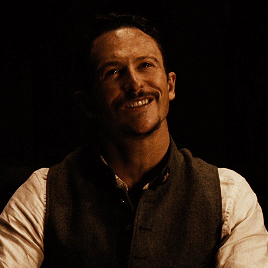
— How unmoved, almost entirely unimpressed Major Craddock is by the death and the rebirth of buried Lieutenant Dunleavy, as he coldly describes “three ounces of Mexican lead in his belly” and accepts the idea that his Lieutenant has been brought back to life with a simple “indeed”, which you can interpret not only as a lack of curiosity but perhaps also as weak emotional attachment to his soldiers, who absolutely deserve it for the lack of any individuality. But I'm getting ahead of myself.
— Something you could probably call hostile hospitality on Major’s part – I mean his eerie, almost theatrical politeness, which wouldn’t fool anyone into thinking that the man isn’t disrespectful and provocative.
— Maybe a couple of other things, such as Craddock’s sharp tongue, macabre humour, fluid movements, or how appetizingly he ate.
— Finally, the fact that Craddock refuses to accept the deal and states the only partnership that would happen would be the rape Dolores and Angela by him and his unit:
Craddock: “My final decision is which of you to keep for myself and which of you to throw out there for my men.”
In other words, demonstration of the dominant position by means of threats of violence.
Here you have it, ladies and gentlemen: the Death bingo.
Oh, and then Teddy shoots Craddock after his statement, but Craddock is brought back to life by a captured Technician. Spoiler alert, I guess?
I’m going to broach everything mentioned, but for now, I want to concentrate on the “eerie politeness”, because the Deaths in high development are almost always characterized by this insincere courtesy, and that for a reason I can explain to you.
In short: the elements Jung calls shadow and persona aspects of the psyche are swapped over in the Death.
Every other character than the Death, including very aggressive specimen, even the Devils, have socially acceptable Dr Jekyll (the Persona) and a repressed, socially unacceptable Mr Hyde (the Shadow) in them. For the Death, the Shadow is its normal, default state, because the archetype doesn’t have the same social needs as other archetypes. It simply doesn’t need to hide its feelings and desires in order to look “normal” – it doesn’t tolerate social conventions.
So, typically, the Death is a 24/7 Mr Hyde. It does have a thin coating of the Persona, but it only uses it on very special occasions, to deceive or to – paradoxically – appear even more intimidating than it already is. This is why Craddock’s attempts to be silver-tongued may cause you discomfort – in these moments, he is a crocodile smiling at you.
Importantly, all of this doesn’t mean that the Death is always a cutthroat that only thinks about torturing animals, burning buildings down, raping women and murdering men. Not at all.
Almost all of the Deaths are able to control themselves to some extent, but this control is carried out by the Animus, not by the Persona. How is this different? The Animus isn’t a social suit, meaning that it isn’t used to appear to others, it’s a personal moral fiber, something close to a codex that prevents the Death, who sees itself as a warrior, from turning into a butcher raping and killing everyone around.
Does this mean that the Devil’s transformation into the Death happens after its acceptance of the Shadow as the terminal state of its personality and almost full rejection of its Persona? Yes, it absolutely does.
By the way, the Persona of the Empress is the Anima, and that’s why the Death inevitably gets into conflict with the Empress as soon as they get in contact. Would you like to guess who Dolores is (confess, she reminds you of Cersei Lannister)?
So, yes, the fact that Craddock joins Dolores’s group as they arrive at Fort Forlorn Hope, where Craddock’s commanding officer agrees to help Dolores in the morning to defeat the incoming security force, shows us another aspect of the Death.
Even though, the archetype is mostly independent, it usually is guided or influenced – sometimes directly, by the Emperors and the Empresses, the Mages and the Hierophants, but more often by the mediators, like the Hanged, the Justices, the Devils or the Towers. (Left to itself, the Death either indulges in debauchery or spends whole days planning ideal crimes/operations and perfecting its murder skills, waiting for someone who will suggest a proper victim to appear.)
And in that respect, the Deaths, generally speaking, fall into two categories – those who end up aligned with the forces of order and those who are, as the Joker puts it, “agents of chaos”, respectively.
How are they different?
The Deaths on the side of order are ideal warriors and guardians of law, because they channel their destructive energy into annihilation of all those who they are told to kill. And the Deaths execute these orders for a two-fold reason:
First, their leaders symbolically embody their parents, since they take responsibility for their actions, which the Deaths greatly appreciate (I’ll get to it in a moment).
And second, the system they serve provides them with the concept of an enemy/victim, thereby relieving them of the need to choose their victims on their own. The Deaths are generally infantile, and many of them can’t or don’t want to – sometimes without realising it – make their own decisions. This makes them ideal objects of manipulation – they are loyal and sufficiently stupid.
The Deaths that are taking the side of the chaos usually become leaders/subleaders themselves, because it is much easier to destroy the world together with your henchmen than to try doing it in splendid solitude. Very interestingly, the henchmen of the Deaths are often marked by them (uniforms, masks, obligatory scarifications etc.), like zombies are marked by signs of decomposition, and thereby represent the extension of the Death’s physical influence.
(And the Deaths from the second category are usually smarter, there are even geniuses among them e.g. Moriarty from Sherlock or the Joker. These Deaths also tend to be more popular due to the disturbing combination of sadism, intelligence and cheerful attitude (we’ll get to that, too) – Negan from the Walking Dead would also be an example of the Death that is a loved strategist).
Is this true for Major Craddock? It is.
His troupe is shown as a splinter group, a gang with him as its leader. They do not appear to be motivated by any ideology, murdering, raping, marauding – in short, embracing outrage as normality. They’re just having what they hold for fun, like a pack of hungry wolves or perhaps rather mad dogs.
Dolores sums up this important characteristic of the Death in the following quote:
Teddy: “These men are animals.”
Dolores: “These men are just children. They don't know any better. They need to be led. We don't stand a chance against the men coming for us if we're fighting alone.”
She uses a key-word I’d like you to remember. “Children.”
Mental age of the Death is always approximately ten-twelve years, which explains not just their easy relationship to violence but also a number of other of their typical characteristics – above all their inability - and usually unwillingness - to build a family or sustain a partnership (which is perfectly fine when you are talking about a reflective individual, but here we certainly aren’t).
Moreover, the Deaths are sexual deviants – paedophilia, bestiality, incest, you name it – everything that can certify perversity and lack of understanding of the concept of intimacy can be found here.
Roughly speaking, the Death is a preceding evolutionary stage of the Devil and the Mage – whereas the Mage is an adult with adult emotions, adult social standing and overall adult psychology, and the Devil is a typical teenager, the Death is a cruel and merry child.
And this easily explains why two possible negative transformations of the Devils are the Emperor and the Death – both of these archetypes are violent, but whereas the Emperor is a superhuman, the Death is an animal. To become one of them, the Devil has to get rid of everything humane in it and learn to see in people either ants below its feet or food. This evolution is a direct consequence of the resolved conflict of “the awkward age”: either you become an adult, or you regress into a child stage; either you reflect on your power and use it consciously or turn it into the defining element of your behavior.
And like a naïve child it is, the Death hates to be tricked by heartless adults. At Fort Forlorn Hope, the Confederados are soon revealed to be mere pawns, as Dolores only needed them to distract the security force: once they are no longer useful, she has Wyatt’s followers brutally murder them. Craddock angrily vows revenge, so Dolores orders Teddy to execute him and his men: however, after Craddock taunts Teddy for simply following Dolores’s orders, Teddy lets them escape.
Just look at what he says:
Craddock: “I been watchin' you. We ain't so different. You and I are both triggermen to tyrants. Except me, I know what I want. But you ain't even sure about that termagant you take your orders from. I look at you, and what I see is pathetic.”

Isn’t it the kind of devaluation a child would use? You may be pointing this gun at me, but you’re still a chicken! Na-na, na-na, boo-boo, we get it, Major. Alas, Teddy doesn’t. Most likely, he doesn’t understand whom he is dealing with here.
And right now you might be wondering whether you can identify the Death by looking at it.
There is no such thing as "prototypical appearance" when it comes to the Deaths, but many of them look racy, wear extravagant or simply expensive clothes (“Westwood!”), have prosthetics, bear scars etc., or can be vaguely attractive.
There are many characters of very specific appearance among the Deaths: they can have physical abnormalities (both innate and acquired) and various types of biomodifications or simply eccentrically approach their image. As a rule, this specificity is connected to their becoming of the Death – it can be both the reason of the transformation into the Death (e.g. a catastrophe leads to irreversible physical and psychological changes of the character) and the direct consequence of it (i.e. the Death changes its appearances as it enters the new phase of its life). I would say that it could be partially true for Major with his uniform, too, if we assume that it was the war which had made him what he is.
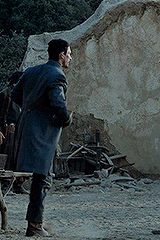
And right now you might be wondering whether this bit was an excuse to insert here a gif with Craddock shaking down his coat… I shall let you be the judge.
Next time we see Craddock, he takes the Man in Black and Lawrence hostage when they come to Las Mudas. He brings them to the church where the townspeople are being kept, and the Man in Black tells him where the town weapons are stored. But not before Major kills the town representative, because he – Craddock – isn’t doing any deals.
Craddock: Now, me and my men here have a long journey ahead of us. We need food, whiskey, and ammunition. You people have some village elder who can speak for you? Make some kind of a deal? (GUNSHOT) (ALL MURMURING) I ain't interested in makin' fuckin' deals. You understand?

Probably inefficient?.. Not for the Death, who operates on intimidation. I bet, Major Craddock could threaten and kill these poor townspeople all day. Because, you see:
Craddock: We know you motherfuckers are rebels. So you’re gonna tell me where the fuck you hid your weapons, or you’re gonna die.
Lawrence: The second we tell him he's gonna kill us all anyway.
But you know what? It is very likely that Lawrence is right, but it isn’t necessarily so. Despite what you might be thinking now, the Deaths aren’t complete strangers to nobleness. Don’t raise your eyebrows, let me explain: they like to challenge and to accept challenges, to find worthy opponents – a victory over an equal or even a superior opponent results in ecstasy of the usually unemotional Death. And this is why sometimes the Death is able to respect an interesting opponent suggesting a one-on-one combat, which, however, probably wouldn’t prevent it from hurting the relatives of the said opponent... Because the Death has its own way of assessing such things. For instance, it can find the murder of a waiter for a spilled tea understandable and condemn a genocide. I’m going to talk about the reasoning behind it later.
Now I’d like to turn to the two defining attributes of the Death apart from sadism – in every sense of the word, including sexual sadism.
First one is its amorality. Even if the Death develops its own moral system, the core at the center of that system becomes the mirror image of the public morals. Many of the Deaths do, indeed, understand the concept of “forbidden”, but this knowledge in the end only tempts them to violate the prohibitions. Most of them, though, aren’t interested in comprehending the concept of moral at all. Take, for instance, Bart from Dirk Gently: she is a holistic murderer, who kills because the universe compels her to. It’s not a part of her job to question why she has to do what she has to do.
Importantly, this factor defines not only the Death’s behavior but its whole way of life – the choices the Deaths make and what these lead them to.
The second defining attribute is gaiety of the Death. That gaiety shouldn’t be mistaken for optimism – the Deaths are rather pessimistic, but at the same time they find evil funny; not to mention the fact that, in many cases, typical manifestations of gaiety, such as smiles and laughter, can express almost any emotion when it comes to the Death. That perverse gaiety also often becomes an important attribute of the Death’s exterior – the Comedian and the Joker probably are the most striking examples for that, – and in combination with vigor and vitality (children are usually very energetic), which are also quite characteristic for the most Deaths, it gives us the archetype that by murdering, raping, torturing, and committing acts of terrorism for its own amusement brings about irreversible changes in the cosmographic picture of its world.
In other words, even though the Death per se is a weak occult figure, it compensates for it with its physical influence on the environment, often becoming one of the most important figures of its fictional universe in the process.
Also, many of the Death are approaching the position of a trickster in their worlds, but due to their primitivism they rarely realize the potential of this possible cosmographic role.
In many ways, it resembles the modus operandi of The Wheel of Fortune – another very physically influential archetype.
And another archetype once played by Tucker, hm. Matthew Brown was the most memorable cameo of the second season of Hannibal, I guarantee you. And it makes sense to give these physical characters to a very physical actor (and person), when you think about it: the way the man moves on camera, almost aggressively at home in his own body, all the tiny nuances of his intimate interactions with the props that are basically creating an additional layer of dialog and of the characters themselves… Isn’t it the best way to breathe life into physical archetypes and simply a wonderful approach to acting? I know, I know, you aren’t here because of my degree in Tuckerology. It’s just hard to talk about the man without professing love.
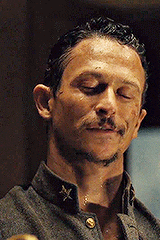
The next thing Major Craddock does is shooting a bartender balancing a glass of nitroglycerine on the back of his hand after the man successfully does for him what he has been told to. Irony or sadism? It’s the same for the Death. You are recalling Ramsay Bolton torturing Theon Greyjoy, aren’t you?
It is worth noting that since the act of murder is perceived by the Deaths as the act of domination over the world, and basically is their biggest source of pleasure, many authors like to stage the battles between the Deaths and the Hermits, who endure great moral suffering even when committing violence in self-defense.
The fact that the Death doesn’t find it shameful to find pleasure in evil and laugh at the absurd and unbearable lightness of being (yes, it sort of is this existential, we’re getting there) may make you think that there isn’t anything holy to the Death at all, but – and the Death has this in common with the Mage – usually something is. It’s just insanely difficult to find, since even the Death doesn’t actually realize it sometimes. Again, think about a very cruel child, who despite everything still is a child and loves, for instance, some TV character or other figure.
And since we are talking about what the Death might like or love, the Deaths usually have a narrow circle of interests, which predictably includes drugs, weapons (Remember the impressed look on Craddock's face after that demonstration of a blaster? Even if you don't, here I have it for you:
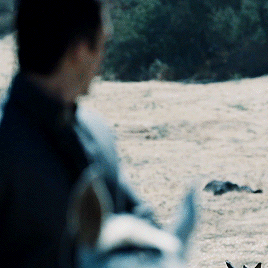
), explosives, violence, sex (rape), terrorism, but also – and this is where it gets interesting – quite often it likes dancing and music, which seems to appease their inner predator; it frequently likes childish activities or things associated with childhood (Simon Adebisi blowing soap bubbles!), animals, with which the Deaths subconsciously feel a certain kinship, games, competitions, fights, sports, food, and clothes.
Also, it usually is quite indifferent to money - again, like a child, who doesn’t understand the value of it; this is one of the traits that help you distinguish the Death from the Wheel of Fortune, who is an avid fan of making profit in all sorts of manners.
But of course there isn’t a thing that the Death generally enjoys more than tormenting people and putting them into uncomfortable situations, which Major Craddock demonstrates by forcefully dancing with Lawrence’s wife in front of him.
Yes, you'll have to believe me that in this particular instance dancing with Jonathan Tucker is actually intended as torture.
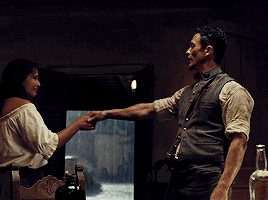

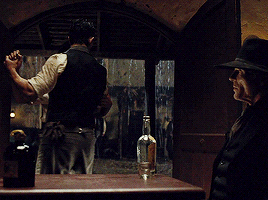
Maybe an interesting connection to a deeper meaning of the card of the archetype is that the Death doesn’t discern between age, race or sex, just as actual terrible misfortunes can potentially happen to everyone. However, being an expert sadist, the Death can and usually will make use of those characteristics of its victim that make them especially vulnerable, be it physical or psychological vulnerability.
For all the reasons discussed above, the Deaths are usually lonesome. The primitiveness of their life philosophy, together with aggressiveness that gives them a dangerous reputation, eventually isolate the Death from the normal people almost completely. Sometimes leaders or quasi-leaders, such as the Mages and the Devils in high stages of their development, the Hanged and the Justices, seek their assistance, but even then they tend to distance themselves from the Deaths in personal interactions.
The young Deaths – usually in their lower stages of development – do not pay attention to this zone of estrangement around them or even like it, seeing it as a confirmation of their value and uniqueness as a source of danger for everyone, including potential allies.
But the older Deaths often suffer from loneliness and try to build a circle of friends but fail almost always.
This loneliness, which is usually a symptom of entering the phase of high development (in which the Death realizes its emotional and social inferiority), can change the Death very much. This is, for example, what the Comedian was going through when he found out about the plan of Ozymandias and realized that he can’t understand a mass murder of those who aren’t his enemies or prey (“We know you motherfuckers are rebels!”). This is when murder becomes barbarity in his eyes, and instead of perceiving it as a joke, he asks: “I mean, what’s funny? What’s so goddamn funny? I don't get it. Somebody explain... somebody explain it to me.”
The Comedian’s isolation indicates the same thing Jake Gallo’s search for life reference points, the tragic nihilism of Ares or Grievous’ perfectionism do – the Death only suffers from its inadequacy.
In other words, golem wants to become a human, but it can’t, because it isn’t designed to play that role. Even if the Death is capable of loving or feeling anything at all, it still looks at the world from a perspective of a blunt metal object: here is me (or mine) and there are them, the enemies, who I/we have to kill. Not to kill to save a world or get something, simply because they are the enemies.
And speaking about what else can hurt the Death: Physical world is very important to it, it craves for contact with it, so, blindness, paralysis or amputation would be enough to destroy the Death’s personality.
But what leads to the actual downfall of the Death? One could assume that it is stupidity or excessive cruelty that leaves the Death without any companion-in-arms in a difficult situation. But no, actually.
What exactly killed Major Craddock?
Remember the “I know what I what” bit? It was this assumption. Because it’s the incipient ambition that usually kills the Death.
We cannot force ourselves to be kin to what is unlike us, and since the Death is a blind branch of the archetypical personal evolution, it is confined to itself. (The Deaths usually do not evolve, but can acquire some resemblance to the Mages with age and certain intellectual growth.) The Death can’t be anything better than an assassin (serving order) or a bandit (serving chaos). The Joker understands it: “You know what I am? I’m a dog chasing cars. I wouldn’t know what to do with one if I caught it! I just do things.”
Major Craddock, on the other hand, doesn’t (didn’t...) seem to realize that the aspirations he connected with an unknown place called Glory, which he was hellbent on making his way to, resulted from the desire to become more than he is – a thug on the side of the losers (the Confederados), an artificial being, a mad dog, lost without someone holding its leash. Someone who never had the free will to decide what he wants to be but was forcefully put into being. I told you it’ll get existential!
Instead, Major thinks that he is the active subject that chooses his fate and was chosen by death, becoming its herald and champion:
Craddock: “Death is an old amigo of mine. I died just recently, in fact. But death can't bear to lay claim on me. So it sent me back here to do its bidding. Because I do it with such goddamn style. I've served death well. And in turn, it'll be watching over us as we cross these lands.”
Right after that The Man in Black explains to him:
The Man in Black: “You think you know death but you don't.”
Given the fact that Craddock is the Death and decided to identify with death after years and years of inflicting violence, you could argue that The Man in Black is basically saying here: “You don’t know yourself, boy”.
And what about what happens then? Well.
The Death has the tendency to escape death for quite some time. Yet when it does die, it’s usually a very horrible way to go: being eaten alive by your own dogs, falling from a great height. And now we can add a nitroglycerin cocktail to this list as well.
And honestly, thank goddess. As much as I love Jonathan Tucker and his characters, the series was painful to watch for me personally. And now I can't wait for City on a Hill, wondering who Tucker’s next archetype is going to be, because the man certainly has an intuitive grasp of these things.
So, this is it. Thank you for you attention and let me know what other Tarot archetype you'd like to learn more about!
#the major arcana#tarot#tarot cards#tarot archetypes#major craddock#westworld#jonathan tucker#the death#character overview#fandom meta
6 notes
·
View notes
Text
Harry Dean Stanton (1926-2017)
Harry Dean Stanton, the sardonic, iconoclastic actor whose off-kilter presence enlivened films and TV series ranging from The Avengers to Pretty in Pink, died Sept. 15 at age 91. A character actor and occasional leading man for nearly seven decades, Stanton stayed active into old age, recently appearing in Showtime’s Twin Peaks revival. Here’s a look at his greatest roles.
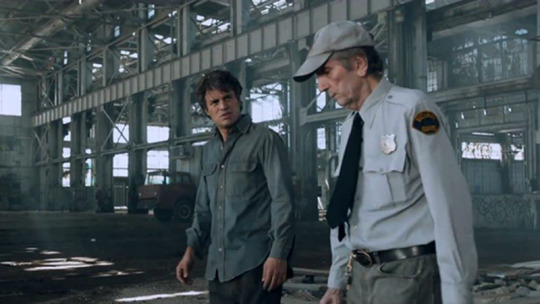
‘The Avengers’ (2012)
The actor pops up in a comedic cameo as a gobsmacked security guard who can’t believe his eyes when the Hulk falls out of the sky and transforms into Bruce Banner.
(Photo: Disney)
Source: Yahoo Movies
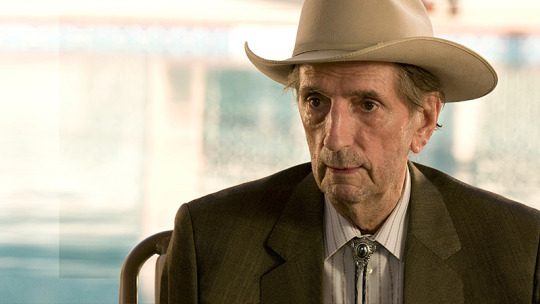
‘Big Love’ (2006-11)
In the acclaimed HBO series, Stanton played Roman Grant, patriarch and “prophet” of a polygamist community, who ends up getting smothered to death as payback for his nefarious, perverted scheming.
(Photo: HBO)
Source: Yahoo Movies

‘The Green Mile’ (1999)
Stanton plays a prison guard nicknamed Toot-Toot who works on death row under Tom Hanks’s Paul Edgecomb in Frank Darabont’s adaptation of Stephen King’s fantasy-drama.
(Photo: Warner Bros.)
Source: Yahoo Movies

‘Twin Peaks’ (1992, 2017)
A longtime friend and frequent collaborator of David Lynch’s, Stanton joined the Twin Peaks weirdness in the 1992 feature film Fire Walk With Me, playing the manager of the Fat Trout Trailer Park, a role he recently reprised in Showtime’s series revival.
(Photo: New Line Cinemas/courtesy Everett Collection)
Source: Yahoo Movies

‘The Last Temptation of Christ’ (1988)
In Martin Scorsese’s controversial Jesus story, which deviates from the traditional gospel, Stanton plays the apostle Paul who refuses to believe Jesus (Willem Dafoe) has ascended to Heaven.
(Photo: Universal/courtesy Everett Collection)
Source: Yahoo Movies

‘Pretty in Pink’ (1986)
In one of his meatiest movie roles, Stanton stars as Molly Ringwald’s down-on-his-luck dad, who tries to make things right with his daughter by giving her a pink prom dress in the John Hughes-scripted teen classic.
(Photo: Everett Collection)
Source: Yahoo Movies
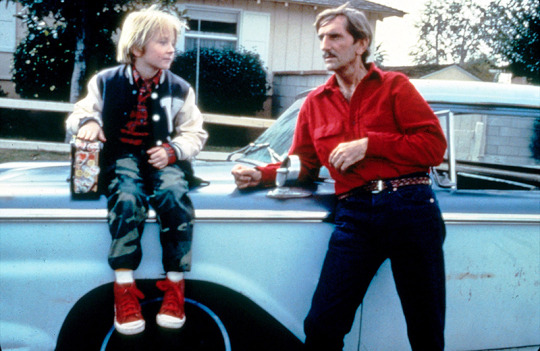
‘Paris, Texas’ (1984)
Stanton has one of his few true starring roles in Wim Wender’s eccentric road-trip film as a man who, after a bout of amnesia, reunites with his young son and embarks on a journey to find his long-lost wife.
(Photo: Mary Evans/Ronald Grant/Everett Collection)
Source: Yahoo Movies

‘Repo Man’ (1984)
Stanton played the repo man Bud who recruits and mentors Emilio Estevez in the bonkers sci-fi cult classic.
(Photo: Universal Pictures/ Courtesy: Everett Collection)
Source: Yahoo Movies
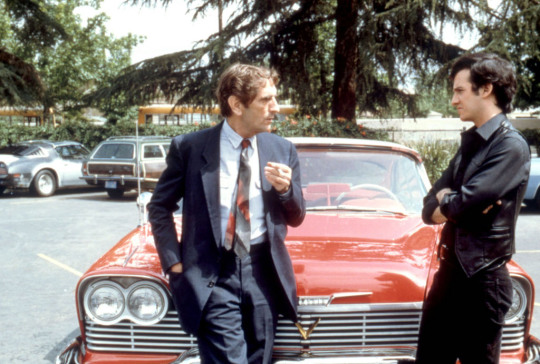
‘Christine’ (1983)
Stanton, per usual, steals scenes as the detective in the John Carpenter-helmed adaptation of Stephen King’s novel about a demonic Plymouth Fury.
(Photo: Columbia Pictures/courtesy Everett Collection)
Source: Yahoo Movies

‘Escape From New York’ (1981)
In John Carpenter’s dystopic sci-fi classic, Stanton co-stars as Brian (“Don’t Call Me Harold”), one of the guys who helps Kurt Russell’s Snake Plissken (spoiler alert!) escape from New York.
(Photo: Avco Embassy/courtesy Everett Collection)
Source: Yahoo Movies

‘Private Benjamin’ (1980)
Stanton memorably plays the Army recruiter who encourages Goldie Hawn’s wayward title character to sign up for the military by promising her it would be like a spa vacation.
(Photo: Warner Bros.)
Source: Yahoo Movies
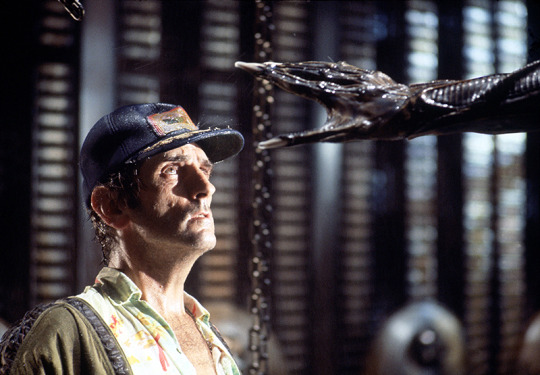
‘Alien’ (1979)
Stanton is the cat-loving technician Brett on the salvage ship Nostromo, who winds up in a close encounter of the wrong kind with the Xenomorph.
(Photo: 20th Century Fox Film)
Source: Yahoo Movies

‘The Godfather Part II’ (1974)
Stanton had a small role in Francis Ford Coppola’s sprawling mafia sequel, playing one of the FBI agents assigned to protect a made man who turns into the state’s witness.
(Photo: The Coppola Company)
Source: Yahoo Movies

‘Two-Lane Blacktop’ (1971)
Stanton stood out in a small role as a gay hitchhiker in Monte Hellman’s counterculture classic starring James Taylor, Warren Oates, Dennis Wilson, and their revved-up GTO.
(Photo: Universal Pictures)
Source: Yahoo Movies
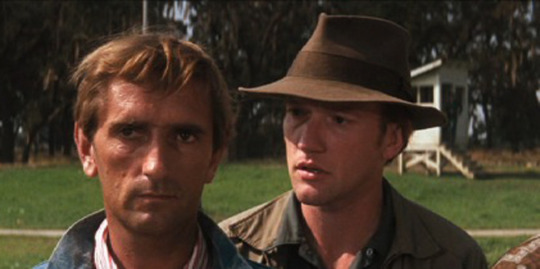
‘Cool Hand Luke’ (1967)
After years of TV bit parts, he scored an early film role (billed as “Dean Stanton”) as a convict called Tramp in this classic Paul Newman-fronted prison drama.
(Photo: Warner Bros.)
Source: Yahoo Movies
#Photos#_revsp:wp.yahoo.movies.us#Slideshow#harry dean stanton#slideshow#_uuid:8ae1f417-3696-38df-b50d-03d9483cda4e#_lmsid:a0Vd000000AE7lXEAT#_category:yct:001000076
67 notes
·
View notes
Text
Life Is Strange 2: The Sims 4 Challenge Behind The Sims Lot 3


This lot overall was my favorite to play in. I had no idea it was this beautiful. No wonder they put the Willow Creek park there.

Originally, this guy wasn't a bad guy. He was just minding his business taking a walk in what he probably expected to be a park, shocked to find that it had vanished from the face of the earth, when I decided to drag him into the story. He was just supposed to introduce Sean and Daniel to Logan's farm and suggest they help an elderly man grow his produce. But I wanted to make it twisty so I turned him into a villain. They had such a nice chat in the beginning. They shared their park hot dogs and everything.

For those who have played The Adventures of Captain Spirit, you may have recognized the resemblance Harley has to Chris. I wanted to have a hint of Chris in the story, but not recreate him. I didn't want this to become just a Sim version of Life Is Strange where I just sim-ulized every character in the game. I did want Daniel to have a friend so I thought this was the best place to put him, especially after Sean ditched him for Abraham...Come on, Sean. Daniel is way cooler.
(And as you can see in the top left corner, I was listening to the Life Is Strange 2 original soundtrack on Spotify. It brought out so much more emotion in the story. It brought the characters to life.)

I almost get emotional every time I think about this, but...As in Adventures of Captain Spirit, Chris’s mom is also an artist just like Sean. I won't say much more because spoiler alert. It's not really a spoiler, but I need you to please play Adventures of Captain Spirit and then we can discuss in more details. It's free and it's like 3-4 hours of gameplay if you like to take your time like I do. It's a wonderful story. Dontnod...thank you for being you. You're the best.

Once again, I got a little overly ambitious. This garden was huge and a good amount of the plants died. Sean had a lot to take care of on his own, because Daniel wasn't so eager to help this time. Not when there's toys around. School really did a number on Sean this challenge. He would come home too tired or tense so he could barely function. I love the gardening activities in this game, but you really have to be on it.
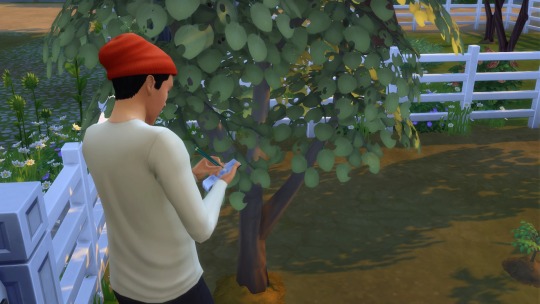
Yes. Take notes. This is what not to do.
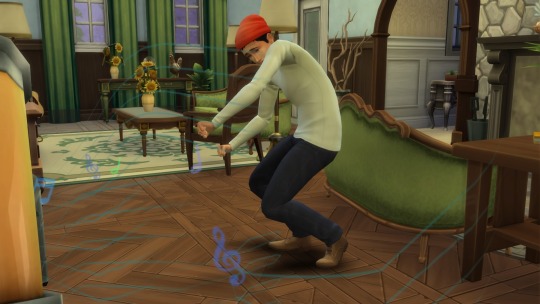
Favorite Sims dance of all time. Go, Sean! Ayyyyy!

Cute little pumpkin pie Daniel just wanted to nap with his big brother all on his own. I thought this was soooooo cute! I don't even care if the bed is soaked with pool water. The bed will dry, but their brotherhood is a river that will flow for eternity.
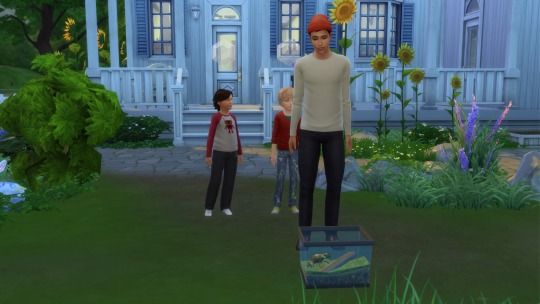
The first and last time we see Basil the Frog. Hopefully, I'll remember to bring him back into the family when I continue the story. I can't just leave him hanging like that.
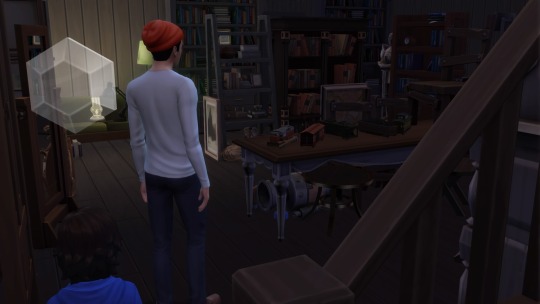
Welcome to Logan's secret lair. I thought this was so cool when I found it in this build, so I had to put it in the storyline.
Fun fact: Logan actually started off as a bank robber who stashed his thieveries behind the secret door. I was going to have Sean see a report about a bank robbery on the news and everything. But then I thought about how I needed police uniforms, police cars, or at least lights so I could make it seem like the police where doing a raid and I'm playing base game so...Psych. Villain guy from the park it is. This turned out way better because Logan ended up being a victim instead of the bad guy. And Sean and Daniel didn't have to digest the fact that they were living with a criminal, sharing his eggs and toast.

Repo guy has some serious swagger. The shades are ridiculous, but perfect for my underground mafia-gang.

I was so excited to build this fair. It's not as functioning as I wish it was (though you can play games and make cupcakes) but it's so pretty. I'm so grateful for bb.moveobjects on. You don't even know. I also wish more sims would come around. I have to figure out a better way to make that happen because it always looked a little empty.

Harley's mom is here. That's all I'm going to say. Harley's mom...Originally, she was going to be more involved with the story with her not having a good relationship with her dad, but since I changed Logan’s story role, I decided not to add her to the story at all.

She was actually in the last scenes of the video if you look closely...
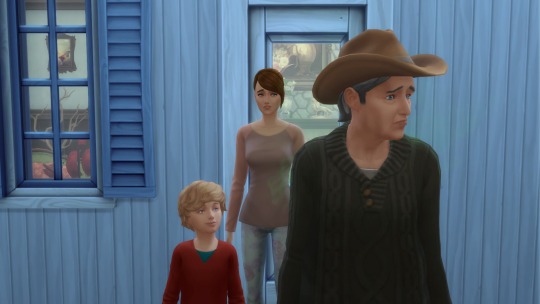
I had to do some tinkering with the camera angles to hide her. I feel bad but, otherwise it wouldn’t have made any sense.

I found Julianna Flores walking by the farmhouse and thought, "She'd make a good authority figure," and added her to the household so I could create this heart-breaking scene. I gave her a makeover and everything. Even though she's kind of cruel and insensitive, I think she looks pretty cool. She is also a portrayal of an original character from Life is Strange 2. FBI agent Maria Flores.

Conclusion:
The hardest part of this challenge was trying to keep the garden alive. I failed multiple times, but I never gave up...Not until the challenge was over. I have other plans for that garden anyway, so hopefully it will be in better and greener hands.
God Bless!
Love, Charly
#LifeIsStrange2TheSims4Challenge#LifeIsStrange2#TheSims4#gaming#SeanDiaz#DanielDiaz#tamersmile#basegameonly#TheSims4BaseGame
0 notes
Text
Quick Take: 2018 Kia Stinger GT
It’s like being the last of your friends to see a movie. You’ve avoided the spoilers, but you also know they loved it. That raises your expectations, even though the previews maybe weren’t so convincing. So when I fired up the 2018 Kia Stinger GT, months after the first writers to drive it, it was with more than a little anticipation.
You see, most of my cohorts in the car business had already driven the Stinger—at the Nürburgring Nordschleife, no less. They’d returned from Germany with Cheshire cat smiles and endless, under-embargo praise. I was a tad skeptical, having driven many Kias prior to the Stinger. But I was hopeful, too. Kia has made such strides in exterior design, interior quality, and powertrain refinement that the foray into sportiness seems inevitable—but success in the sporting arena is anything but a given, even for the established players.
To say the Stinger GT faced a high hurdle from its inception is to misunderstand the challenge. Taking on the likes of the BMW 4 and 6 Series, the Porsche Panamera, and the Audi S5 Sportback is functionally impossible, even with a competitive product. Why? Because Kia lacks the heritage, reputation, and brand cachet of the German luxury marques. Fortunately, Kia knows that and doesn’t waste its effort trying to be something it’s not (not yet, anyway). Instead, it aims for a more achievable goal: a genuinely sporty sedan that ticks enough boxes to be the rational choice over its venerable ersatz rivals.
I wasn’t let down, exactly, but I also didn’t get the wig-pushed-back amazement of a two-thumbs-up summer blockbuster. You certainly can’t blame the roads—Angeles National Forest has some of the best in the country, easily up to the task of displaying the goods of any car with performance aspirations. It’s not that the Stinger GT isn’t a very good sport sedan. It’s that it’s not as good as I’d hoped, given all the tongue wagging by other scribes.
The problem, ultimately, is with rationality. After a day behind the wheel of the Stinger GT, I can say with all seriousness that it is the rational choice over a BMW 440i or even a base-level Panamera. It’s just as comfy as either German, nearly as nice inside (less so compared to the Porsche), accelerates quicker, handles with similar alacrity, and costs somewhere between two-thirds and half as much. But as much as the world’s luxury brands tout their engineering, their build quality, and their design, the rational decision—made with dollars and cents, not emotions and desires—will only rarely land you in one of their cars.
There’s passion in the Stinger GT, though. With Albert Biermann, former vice president of engineering at BMW’s M GmbH, at the helm of Hyundai-Kia’s vehicle testing and high-performance development group, the Stinger has real performance bona fides despite having no heritage to draw on in the rear-drive sport sedan arena. And it’s certainly not rationality that makes you stick a twin-turbocharged, 3.3-liter V-6 engine rated at 365 hp (at 6,000 rpm) and 376 lb-ft of torque (from 1,300 to 4,500 rpm) lengthwise into a family sedan. Rationality does strike with the use of an eight-speed automatic transmission, but that’s quickly forgotten when you realize, upon turning off all the electronic nannies, that the instrument panel is telling you launch control is now available. Peg the brakes, pin the gas, and then bam! You’re off as soon as the brake is released.
Claimed 0 to 60 mph? Just 4.7 seconds. It feels faster. Fortunately the four-piston Brembo brakes up front do their work neatly, hauling the car down from speed with reasonable feel. Turn in for a hard corner, and you’ll notice the lack of initial body control, letting the car almost flop into the turn. I suspect this is down to the tuning of the progressive-rate springs, rather than damping, and it pays dividends in ride quality, but it leaves the Stinger GT feeling a bit soft and lazy on the front end, especially when compared back to back with the Porsche Panamera. Once the car has leaned sufficiently to reach the higher-rate portion of the springs, however, body motion is well controlled, and transitioning to profitable throttle application is easy. If you’re a bit more abrupt on the throttle, you can break the rear loose easily, and thanks to the long wheelbase, it’s easy to hang it out as long as you’d like. It’s not the sharpest knife in the drawer, but it’ll cut the mustard.
The Stinger GT’s all-wheel-drive system has perceptible rear bias when driven hard, too. But even in the rear-drive-only model, with the Stinger GT’s safety equipment in maximum alert, it’s all but impossible to slide the car more than a few feet—which should reassure drivers curious about the dynamics of a rear-wheel-drive car but not yet used to the delicacy required on the throttle in wet or wintry conditions.
Let’s face it, as much as the Stinger GT can be included reasonably in company with the likes of BMW, Mercedes, and Porsche, its actual customer base is more likely to come from brands like Honda, Toyota, and Nissan. That customer base hasn’t had much experience with rear-wheel-drive cars. Naturally, many (perhaps even most) will opt for the all-wheel-drive system. But for those value buyers grabbing a standard Stinger (not the GT) on the strength of its good looks and roomy interior, the lower-cost rear-drive model will be the go-to pick.
Maybe—just maybe—if we’re lucky, those matinee Stingers will become cult classics and, like “Repo Man” or “The Big Lebowski,” grow a culture of midnight-showing enthusiasts around them, inoculating yet another generation with the love of rear-drive sport sedans and cars that are about more than just the basics, even while being basic.
2018 Kia Stinger Specifications ON SALE Now PRICE $32,800 (base), $39,250 (GT) ENGINE 2.0L turbocharged DOHC 16-valve I-4/255 hp @ 6,200 rpm, 260 lb-ft @ 1,400-4,000 rpm
3.3L twin-turbo DOHC 24-valve V-6/365 hp @ 6,000 rpm, 376 lb-ft @ 1,300-4,500 rpm TRANSMISSION 8-speed automatic LAYOUT 4-door, 5-passenger, front-engine, RWD/AWD sedan EPA MILEAGE 19-22/25-29 mpg (city/hwy) L x W x H 190.2 x 73.6 x 55.1 in WHEELBASE 114.4 in WEIGHT 3,611-4,023 lb 0-60 MPH 4.7 sec (est, GT) TOP SPEED N/A
IFTTT
0 notes
Text
Quick Take: 2018 Kia Stinger GT
It’s like being the last of your friends to see a movie. You’ve avoided the spoilers, but you also know they loved it. That raises your expectations, even though the previews maybe weren’t so convincing. So when I fired up the 2018 Kia Stinger GT, months after the first writers to drive it, it was with more than a little anticipation.
You see, most of my cohorts in the car business had already driven the Stinger—at the Nürburgring Nordschleife, no less. They’d returned from Germany with Cheshire cat smiles and endless, under-embargo praise. I was a tad skeptical, having driven many Kias prior to the Stinger. But I was hopeful, too. Kia has made such strides in exterior design, interior quality, and powertrain refinement that the foray into sportiness seems inevitable—but success in the sporting arena is anything but a given, even for the established players.
To say the Stinger GT faced a high hurdle from its inception is to misunderstand the challenge. Taking on the likes of the BMW 4 and 6 Series, the Porsche Panamera, and the Audi S5 Sportback is functionally impossible, even with a competitive product. Why? Because Kia lacks the heritage, reputation, and brand cachet of the German luxury marques. Fortunately, Kia knows that and doesn’t waste its effort trying to be something it’s not (not yet, anyway). Instead, it aims for a more achievable goal: a genuinely sporty sedan that ticks enough boxes to be the rational choice over its venerable ersatz rivals.
I wasn’t let down, exactly, but I also didn’t get the wig-pushed-back amazement of a two-thumbs-up summer blockbuster. You certainly can’t blame the roads—Angeles National Forest has some of the best in the country, easily up to the task of displaying the goods of any car with performance aspirations. It’s not that the Stinger GT isn’t a very good sport sedan. It’s that it’s not as good as I’d hoped, given all the tongue wagging by other scribes.
The problem, ultimately, is with rationality. After a day behind the wheel of the Stinger GT, I can say with all seriousness that it is the rational choice over a BMW 440i or even a base-level Panamera. It’s just as comfy as either German, nearly as nice inside (less so compared to the Porsche), accelerates quicker, handles with similar alacrity, and costs somewhere between two-thirds and half as much. But as much as the world’s luxury brands tout their engineering, their build quality, and their design, the rational decision—made with dollars and cents, not emotions and desires—will only rarely land you in one of their cars.
There’s passion in the Stinger GT, though. With Albert Biermann, former vice president of engineering at BMW’s M GmbH, at the helm of Hyundai-Kia’s vehicle testing and high-performance development group, the Stinger has real performance bona fides despite having no heritage to draw on in the rear-drive sport sedan arena. And it’s certainly not rationality that makes you stick a twin-turbocharged, 3.3-liter V-6 engine rated at 365 hp (at 6,000 rpm) and 376 lb-ft of torque (from 1,300 to 4,500 rpm) lengthwise into a family sedan. Rationality does strike with the use of an eight-speed automatic transmission, but that’s quickly forgotten when you realize, upon turning off all the electronic nannies, that the instrument panel is telling you launch control is now available. Peg the brakes, pin the gas, and then bam! You’re off as soon as the brake is released.
Claimed 0 to 60 mph? Just 4.7 seconds. It feels faster. Fortunately the four-piston Brembo brakes up front do their work neatly, hauling the car down from speed with reasonable feel. Turn in for a hard corner, and you’ll notice the lack of initial body control, letting the car almost flop into the turn. I suspect this is down to the tuning of the progressive-rate springs, rather than damping, and it pays dividends in ride quality, but it leaves the Stinger GT feeling a bit soft and lazy on the front end, especially when compared back to back with the Porsche Panamera. Once the car has leaned sufficiently to reach the higher-rate portion of the springs, however, body motion is well controlled, and transitioning to profitable throttle application is easy. If you’re a bit more abrupt on the throttle, you can break the rear loose easily, and thanks to the long wheelbase, it’s easy to hang it out as long as you’d like. It’s not the sharpest knife in the drawer, but it’ll cut the mustard.
The Stinger GT’s all-wheel-drive system has perceptible rear bias when driven hard, too. But even in the rear-drive-only model, with the Stinger GT’s safety equipment in maximum alert, it’s all but impossible to slide the car more than a few feet—which should reassure drivers curious about the dynamics of a rear-wheel-drive car but not yet used to the delicacy required on the throttle in wet or wintry conditions.
Let’s face it, as much as the Stinger GT can be included reasonably in company with the likes of BMW, Mercedes, and Porsche, its actual customer base is more likely to come from brands like Honda, Toyota, and Nissan. That customer base hasn’t had much experience with rear-wheel-drive cars. Naturally, many (perhaps even most) will opt for the all-wheel-drive system. But for those value buyers grabbing a standard Stinger (not the GT) on the strength of its good looks and roomy interior, the lower-cost rear-drive model will be the go-to pick.
Maybe—just maybe—if we’re lucky, those matinee Stingers will become cult classics and, like “Repo Man” or “The Big Lebowski,” grow a culture of midnight-showing enthusiasts around them, inoculating yet another generation with the love of rear-drive sport sedans and cars that are about more than just the basics, even while being basic.
2018 Kia Stinger Specifications ON SALE Now PRICE $32,800 (base), $39,250 (GT) ENGINE 2.0L turbocharged DOHC 16-valve I-4/255 hp @ 6,200 rpm, 260 lb-ft @ 1,400-4,000 rpm
3.3L twin-turbo DOHC 24-valve V-6/365 hp @ 6,000 rpm, 376 lb-ft @ 1,300-4,500 rpm TRANSMISSION 8-speed automatic LAYOUT 4-door, 5-passenger, front-engine, RWD/AWD sedan EPA MILEAGE 19-22/25-29 mpg (city/hwy) L x W x H 190.2 x 73.6 x 55.1 in WHEELBASE 114.4 in WEIGHT 3,611-4,023 lb 0-60 MPH 4.7 sec (est, GT) TOP SPEED N/A
IFTTT
0 notes
Text
Quick Take: 2018 Kia Stinger GT
It’s like being the last of your friends to see a movie. You’ve avoided the spoilers, but you also know they loved it. That raises your expectations, even though the previews maybe weren’t so convincing. So when I fired up the 2018 Kia Stinger GT, months after the first writers to drive it, it was with more than a little anticipation.
You see, most of my cohorts in the car business had already driven the Stinger—at the Nürburgring Nordschleife, no less. They’d returned from Germany with Cheshire cat smiles and endless, under-embargo praise. I was a tad skeptical, having driven many Kias prior to the Stinger. But I was hopeful, too. Kia has made such strides in exterior design, interior quality, and powertrain refinement that the foray into sportiness seems inevitable—but success in the sporting arena is anything but a given, even for the established players.
To say the Stinger GT faced a high hurdle from its inception is to misunderstand the challenge. Taking on the likes of the BMW 4 and 6 Series, the Porsche Panamera, and the Audi S5 Sportback is functionally impossible, even with a competitive product. Why? Because Kia lacks the heritage, reputation, and brand cachet of the German luxury marques. Fortunately, Kia knows that and doesn’t waste its effort trying to be something it’s not (not yet, anyway). Instead, it aims for a more achievable goal: a genuinely sporty sedan that ticks enough boxes to be the rational choice over its venerable ersatz rivals.
I wasn’t let down, exactly, but I also didn’t get the wig-pushed-back amazement of a two-thumbs-up summer blockbuster. You certainly can’t blame the roads—Angeles National Forest has some of the best in the country, easily up to the task of displaying the goods of any car with performance aspirations. It’s not that the Stinger GT isn’t a very good sport sedan. It’s that it’s not as good as I’d hoped, given all the tongue wagging by other scribes.
The problem, ultimately, is with rationality. After a day behind the wheel of the Stinger GT, I can say with all seriousness that it is the rational choice over a BMW 440i or even a base-level Panamera. It’s just as comfy as either German, nearly as nice inside (less so compared to the Porsche), accelerates quicker, handles with similar alacrity, and costs somewhere between two-thirds and half as much. But as much as the world’s luxury brands tout their engineering, their build quality, and their design, the rational decision—made with dollars and cents, not emotions and desires—will only rarely land you in one of their cars.
There’s passion in the Stinger GT, though. With Albert Biermann, former vice president of engineering at BMW’s M GmbH, at the helm of Hyundai-Kia’s vehicle testing and high-performance development group, the Stinger has real performance bona fides despite having no heritage to draw on in the rear-drive sport sedan arena. And it’s certainly not rationality that makes you stick a twin-turbocharged, 3.3-liter V-6 engine rated at 365 hp (at 6,000 rpm) and 376 lb-ft of torque (from 1,300 to 4,500 rpm) lengthwise into a family sedan. Rationality does strike with the use of an eight-speed automatic transmission, but that’s quickly forgotten when you realize, upon turning off all the electronic nannies, that the instrument panel is telling you launch control is now available. Peg the brakes, pin the gas, and then bam! You’re off as soon as the brake is released.
Claimed 0 to 60 mph? Just 4.7 seconds. It feels faster. Fortunately the four-piston Brembo brakes up front do their work neatly, hauling the car down from speed with reasonable feel. Turn in for a hard corner, and you’ll notice the lack of initial body control, letting the car almost flop into the turn. I suspect this is down to the tuning of the progressive-rate springs, rather than damping, and it pays dividends in ride quality, but it leaves the Stinger GT feeling a bit soft and lazy on the front end, especially when compared back to back with the Porsche Panamera. Once the car has leaned sufficiently to reach the higher-rate portion of the springs, however, body motion is well controlled, and transitioning to profitable throttle application is easy. If you’re a bit more abrupt on the throttle, you can break the rear loose easily, and thanks to the long wheelbase, it’s easy to hang it out as long as you’d like. It’s not the sharpest knife in the drawer, but it’ll cut the mustard.
The Stinger GT’s all-wheel-drive system has perceptible rear bias when driven hard, too. But even in the rear-drive-only model, with the Stinger GT’s safety equipment in maximum alert, it’s all but impossible to slide the car more than a few feet—which should reassure drivers curious about the dynamics of a rear-wheel-drive car but not yet used to the delicacy required on the throttle in wet or wintry conditions.
Let’s face it, as much as the Stinger GT can be included reasonably in company with the likes of BMW, Mercedes, and Porsche, its actual customer base is more likely to come from brands like Honda, Toyota, and Nissan. That customer base hasn’t had much experience with rear-wheel-drive cars. Naturally, many (perhaps even most) will opt for the all-wheel-drive system. But for those value buyers grabbing a standard Stinger (not the GT) on the strength of its good looks and roomy interior, the lower-cost rear-drive model will be the go-to pick.
Maybe—just maybe—if we’re lucky, those matinee Stingers will become cult classics and, like “Repo Man” or “The Big Lebowski,” grow a culture of midnight-showing enthusiasts around them, inoculating yet another generation with the love of rear-drive sport sedans and cars that are about more than just the basics, even while being basic.
2018 Kia Stinger Specifications ON SALE Now PRICE $32,800 (base), $39,250 (GT) ENGINE 2.0L turbocharged DOHC 16-valve I-4/255 hp @ 6,200 rpm, 260 lb-ft @ 1,400-4,000 rpm
3.3L twin-turbo DOHC 24-valve V-6/365 hp @ 6,000 rpm, 376 lb-ft @ 1,300-4,500 rpm TRANSMISSION 8-speed automatic LAYOUT 4-door, 5-passenger, front-engine, RWD/AWD sedan EPA MILEAGE 19-22/25-29 mpg (city/hwy) L x W x H 190.2 x 73.6 x 55.1 in WHEELBASE 114.4 in WEIGHT 3,611-4,023 lb 0-60 MPH 4.7 sec (est, GT) TOP SPEED N/A
IFTTT
0 notes